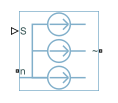Controlled Current Source (Three-Phase)
Ideal three-phase controlled current source
Libraries:
Simscape /
Electrical /
Sources
Description
The Controlled Current Source (Three-Phase) block represents an ideal three-phase current source that is powerful enough to maintain the specified current through it regardless of the voltage across it. The output currents are [ia ib ic] = S, where S is a vector containing the numerical values presented at the physical signal port.
The figure shows the equivalent circuit for the expanded implementation of the Controlled Current Source (Three-Phase) block.

To use the Controlled Current Source (Three-Phase) block as an abstracted current controller in an electrical drive, connect the conserving ports for the output current directly to the machine.
To choose the input type of this block, set the Input type
parameter to Instantaneous or Sinusoidal
magnitude and phase shift. If you select
Instantaneous, this block works only in time simulation
mode. If you select Sinusoidal magnitude and phase shift,
this block works in both time and frequency-time simulation modes. For more information,
see Frequency and Time Simulation Mode.
To access the implementation with an expanded, three-phase port, double-click the block and
set the Modeling option parameter to Expanded
three-phase ports.
Examples
Ports
Input
Conserving
Parameters
Extended Capabilities
Version History
Introduced in R2018b

